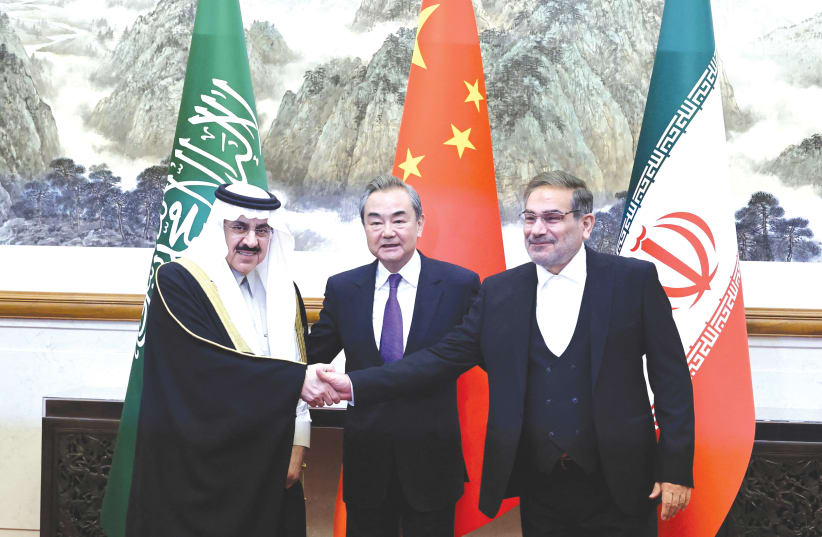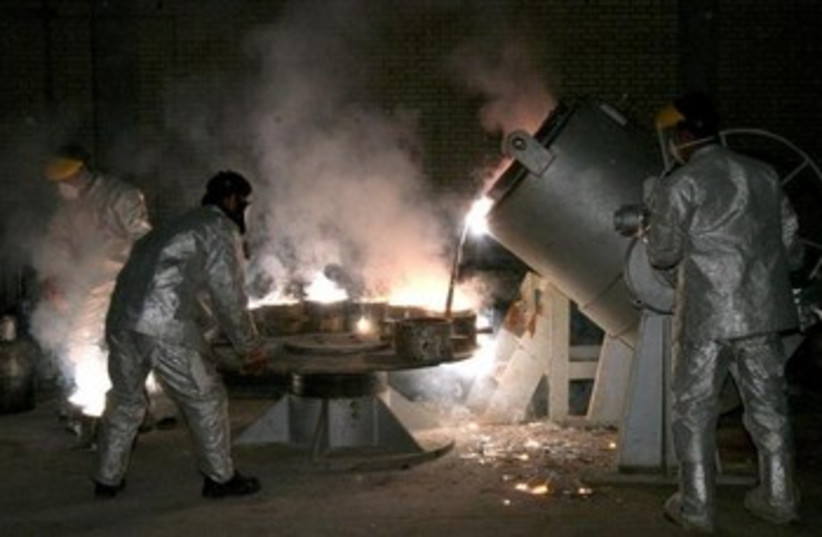Israel has a grand strategy to battle Iran’s attempts to obtain nuclear weapons and to achieve hegemony in the region.
The strategy included a mix of covert and cyber operations against Iran’s nuclear assets and individuals connected to the nuclear program as well as diplomatic efforts to isolate Iran both globally in the US/EU arena and regionally among the many Sunni Arab states.
Sometimes the strategy has worked brilliantly and sometimes it has flopped, but recent days and weeks have shown that the Islamic Republic is doing its best to challenge the foundation of the strategy itself.
Jerusalem does not need anyone’s permission to carry out covert or cyber operations against Tehran and its nuclear program. But there is certainly more room and legitimacy to do so when the majority of the region’s Arab countries, led by Saudi Arabia, feel threatened by the ayatollahs and have open hostilities with the Shiite axis.
Iran is advancing ties with other Middle East nations
Instead, last month the Saudis signed a deal with Iran to end hostilities and return to exchanging ambassadors for the first time since 2016.
Reciprocal visits are also expected by the countries’ foreign ministers and potentially even the country’s presidents or heads of state in the near future.
Only weeks before Iran and the Saudis signed their deal, Tehran had been caught red-handed enriching uranium to the 84% level, the closest it had ever dared to get to 90% weaponized uranium for a potential nuclear bomb.
Only days before the Iran-Saudi deal and right before the IAEA Board of Governors was due to issue a third loud condemnation of Iran and possibly a referral to the UN Security Council for global snapback sanctions, a dramatic deal was struck between the Islamic Republic and the IAEA.
Almost two months later, the signs are that the drama was once again superficial and that the IAEA and the West fell for yet another ploy by Tehran.
Back in early March, IAEA Director-General Rafael Grossi had said there would be intense contact to make sure that the ayatollahs kept up with their commitments within 7-10 days.
There has been zero public follow-up.
Iran is asserting its influence on the Middle East
But as the IAEA front went quiet, Iraqi President Abdul Latif Rashid met this week with Iran Supreme Leader Ayatollah Ali Khamenei in Tehran where he was told that “even one American” is too much in Iraq.
Rashid is not expected to expel the remaining US advisers, especially after US Secretary of Defense Lloyd Austin recently visited, but the statement showed Khamenei’s rising confidence in his influence in the region.
On Wednesday, Iran President Ebrahim Raisi is expected to visit Syria, the first time a head of state from the Islamic Republic has visited Damascus in over a decade since the 2011 Civil War broke out.
This is part of a process to bring Syria back into the fold of the Arab League.
Such a move could pose a significant threat to Israel assuming that the Bashar Assad regime continues to allow Khamenei access to make trouble for Israel within Syrian territory even as Damascus regains its own legitimacy.
Will Israel find it as easy to hit Iranian weapons transfers in Syria if Assad is now also backed by Crown Prince Mohammad Bin Salman?
There have also been reports that the Saudis are seeking negotiations with Hezbollah, possibly to help stabilize the situation between the Iranian Shiite proxy group and the Sunnis proxies in Lebanon.
This would run in parallel to Iranian-Saudi efforts to end or calm the Sunni-Shiite proxy war in Yemen.
As all of this has been going on, Iran has only raised the level of its proxies using rockets and other terror means against Israel.
It has also restarted some of its maritime piracy against US-allied ships, and not long ago its proxies killed some US personnel in Syria.
US and Europe's hand is weakening
By the time the IAEA meets again next month, even if no progress has been made in slowing Khamenei’s steady progress toward a potential nuclear arsenal, the US and the EU may have a weaker hand.
True, they are threatened by Iran in a general way and Israel remains threatened by the ayatollahs in a grave and specific way. But it will be harder for Jerusalem and the West to argue for tougher measures and that the situation is desperate if the Sunni Arab world is allying with the Islamic Republic.
If “only” Israel feels threatened at the moment (Western Europe is still out of range of the rockets that Iran has manufactured to date) and the rest of the Middle East feels Khamenei is acting more responsibly, what is the rush to resolve the nuclear issue?
Iran can say that even if it keeps building advanced centrifuges and a larger uranium stock and as long as it does not cross the 90% weaponized threshold, its whole program is nominally “peaceful.”
The US and the EU know such a claim would be nonsense, but since they are afraid of a direct confrontation with Iran in the first place, any success Khamenei has at moderating Sunni opposition in the region to his regime could make a big difference.
America will continue to send signs to Tehran not to cross the 90% threshold, such as its flyovers of nuclear-armed bombers or bunker-buster armed A-10 Warthogs, but veiled threats will only slow, not halt the Iranian nuclear march.
If Iran can achieve this new equilibrium, will it remain there on the nuclear threshold, just building up its quantities of 60% and 20% enriched uranium from the current four potential nuclear bombs to six to 10? Or will it try to push the envelope further and see if its improved relations with the Sunni states can protect it from a US or Israeli response?
Nothing is ever stagnant in the Middle East, so we will likely know the answer soon.

